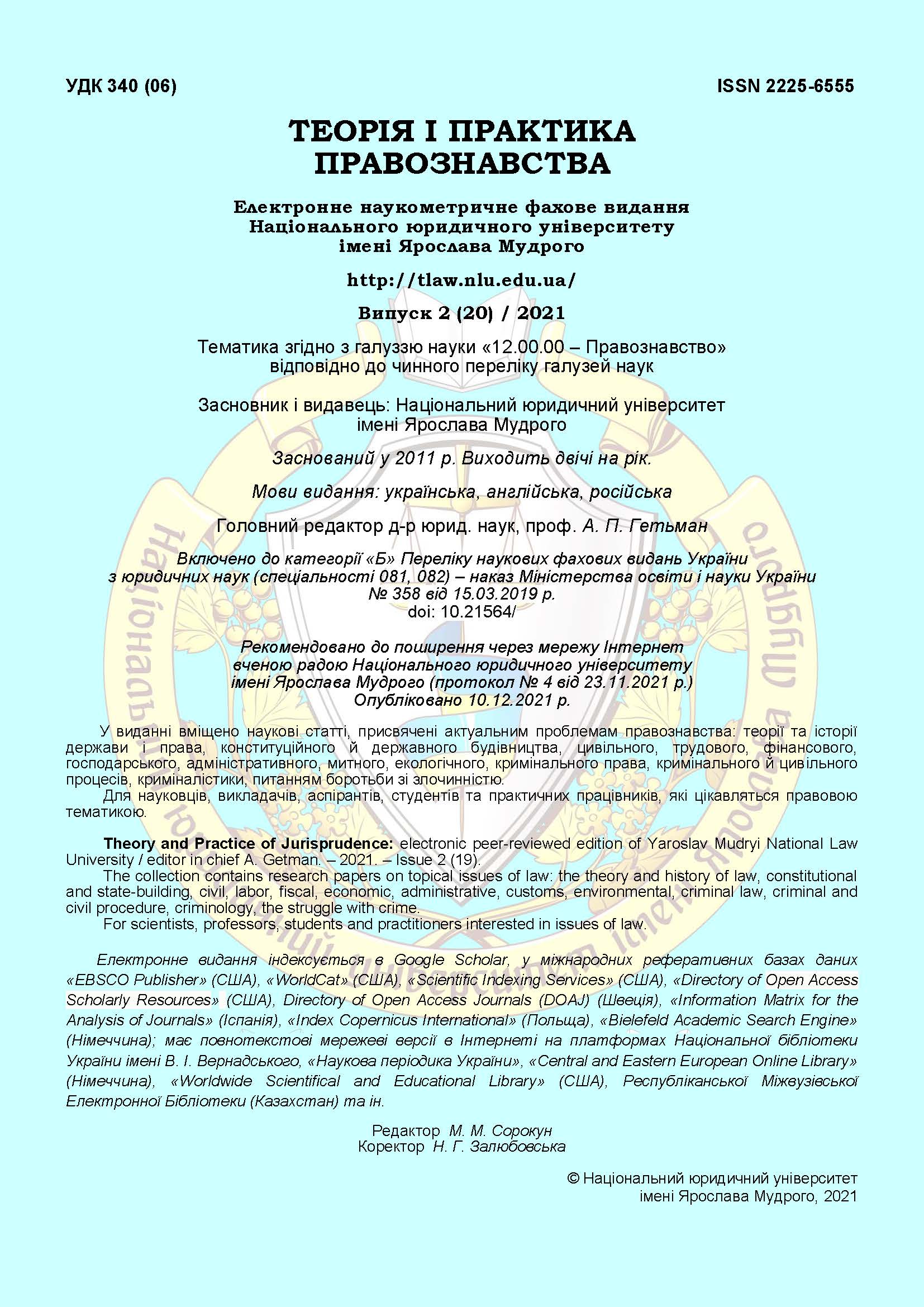System approach in criminal law: achievements and prospects of application
DOI:
https://doi.org/10.21564/2225-6555.2021.2.240557Keywords:
criminal law, system approach, model of crime, IDEF0 notationAbstract
The solution of fundamental problems of criminal-law regulation should be carried out taking into account doctrinal scientific developments and the latest achievements of scientific and technological progress. In this sense, using of a system approach is expanded, which has now received significant instrumental support in the format of information technology and software.
A system approach is a methodological direction of scientific knowledge of system objects by means of system engineering, which is implemented in two main areas – in the field of methodology and theory, and in the field of specific applications.
The aim of the paper is a comprehensive description of using of system approach in domestic criminal law. The task is to outline the prospects of applying a system approach in domestic criminal law, taking into account the latest technologies of systems engineering.
Criminal law in its essence can be understood as a system of information (knowledge) that outlines the criminal offenses’ types and criminal law measures of state reaction to them. As a systemic object, this phenomenon is characterized by several circumstances.
- System components of criminal law. First of all, the authors are talking about the systemic nature of a crime, according to which the system of criminal law regulation is oriented. The systems are also criminal law provisions. Their structural elements-subsystems are hypothesis, disposition and sanction
- The system of criminal law has its own structure. The initial elements of its structure are criminal law. This also includes atypical regulations: criminal law constructions, legal presumptions and fictions. According to the degree of generalization, legal norms and atypical normative prescriptions are united into legal institutions. The systemic structure of the studied system object is manifested in the multiplicity of relations between them.
- System connections of criminal law. In the system of criminal law, informational connections are realized.
- Functioning of criminal law system in the system environment. Through the mechanisms of rule-making, information from protected social relations is introduced into it from the outside, and through the mechanisms of law enforcement, it affects its environment.
According to the system approach, a model of the crime system and the system of the Criminal Code of Ukraine is proposed, developed on the basis of IDEF0 notation
References
Bazhanov, M.Y. (2012). K voprosu o funktsyiakh sostava prestuplenyia. Yzbrannie trudi. V.Ya. Tatsyi (Ed.). Kharkov: Pravo [in Russian].
Baulin, Yu., Ponomarenko, Yu. (2017). Systemnist u kryminalnomu pravi ta kryminalnomu zakonodavstvi. Pravo Ukrainy – Law of Ukraine, issue 5, 88–95 [in Ukrainian].
Blauberh, Y.V., Yudyn, Е. N. (1972). Stanovlenye y sushchnost systemnoho podkhoda. Moscow: Nauka [in Russian].
Hanba, B.P. (2001). Systemnyi pidkhid ta yoho zastosuvannia v doslidzhenni Ukrainy yak demokratychnoi, sotsialnoi, pravovoi derzhavy/ Candidate’s thesis. Kyiv [in Ukrainian].
Hylynskyi, Ya.Y. (1981). O systemnom podkhode k prestupnosty. Pravovedenye – Jurisprudence, issue 5, 49–56 [in Russian].
Kokhaniuk, T.S. (2009). Systemnyi pidkhid u kryminalnomu pravi ta systemnist kryminalnoho kodeksu Ukrainy. Naukovyi visnyk Lvivskoho derzhavnoho universytetu vnutrishnikh sprav – Naukovyi visnyk Lvivskoho derzhavnoho universytetu vnutrishnikh sprav, issue 2, 1–10 [in Ukrainian].
Liamets, V.I., Teviashev, A.D. (2004). Systemnyi analiz. Vstupnyi kurs. Kharkiv: KhNURE [in Ukrainian].
Matsa, K.A. (2008). Systemi neorhanycheskye, orhanycheskye, sotsyalnie: svoistva y pryntsypi orhanyzatsyy. Kyiv: Obrii [in Russian].
Metodі yssledovanyi і orhanyzatsyiі еksperymentov. (2002). K.P. Vlasov (Ed.). Kharkov: Humanytarnіі Tsentr [in Russian].
Obolentsev, V.F. (2016). Bazovi zasady systemnoho analizu zlochynnosti ta viktymizatsii v Ukraini. Kharkiv: Yurait [in Ukrainian].
Obolentsev, V.F. (2018). Bazovi zasady systemnoho analizu systemy derzhavy Ukrainy. Kharkiv: Pravo [in Ukrainian].
Obolentsev, V.F. (2021). Bazovi zasady systemnoho analizu systemy zapobihannia zlochynnosti v Ukraini. Kharkiv: Yurait [in Ukrainian].
Obolentsev, V.F., Hutsa, O.N., Yeromenko, V.V. (2020). Dosvid tsyfrovoho modeliuvannia systemy konstytutsii Ukrainy u notatsii IDEF0. Teoriia i praktyka pravoznavstva – Theory and practice of jurisprudence, issue 15. URL: http://tlaw.nlu.edu.ua/article/download/218892/218854 [in Ukrainian].
Panov, M.I. (2012). Systemnyi pidkhid u kryminalnomu pravi ta problemy udoskonalennia kryminalnoho zakonodavstva. Pravo Ukrainy – Law of Ukraine, issue 6, 226–241 [in Ukrainian].
Soroka, K.O. (2005). Osnovy teorii system i systemnoho analizu. Kharkiv: FOP Tymchenko [in Ukrainian].
Baulin, Yu.V., Burominkyi, M.V., Holina, V.V. et al. (2015). Suchasna kryminalno-pravova systema v Ukraini: realii ta perspektyvy. Kyiv: VAITE [in Ukrainian].
Uzlov, D.Yu., Strukov, V.M., Vlasov, O.M. et al. (2018). Prykladnyi kryminalnyi analiz na bazi informatsiino-analitychnoi systemy «RIKAS». Kharkiv: Yurait [in Ukrainian].
Downloads
Published
How to Cite
Issue
Section
License
Copyright (c) 2021 Obolentsev V. F.

This work is licensed under a Creative Commons Attribution 4.0 International License.




